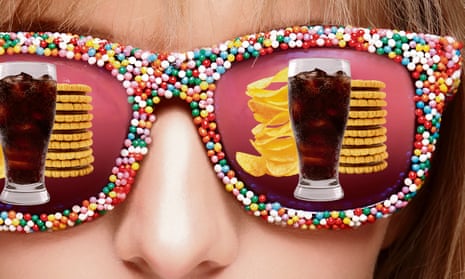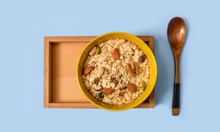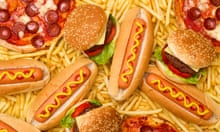Whenever I open a “sharing” bag of my favourite crisps (150g, five servings), I never mean to eat them all. Sometimes I succeed in eating only half and putting the rest back in the cupboard. But the open packet preys on my mind. I can’t concentrate on anything else until I take it out again and scoff the lot, licking every last bit of the tangy, salty coating off my fingers. It’s incredibly delicious. But immediately afterwards I feel a bit sick, and a bit ashamed, and vow never to do it again. Sooner or later, of course, I do.
It might not be crisps for you. It might be chocolate, or ice-cream, or fizzy drinks. These ultra-processed foods (UPFs), which we know are extremely harmful to health, are designed to be hyper-palatable and overeaten. Now researchers believe they are not just hard to resist – they are actually addictive. An analysis of 281 studies in 36 countries by scientists from the US, Spain and Brazil, published in the BMJ, found that 14% of adults and 12% of children have a food addiction, and the food they are addicted to is ultra-processed.
The lead author of the review, Prof Ashley Gearhardt of the University of Michigan, created the Yale Food Addiction Scale in 2009 to measure the problem. “I took the standard diagnostic criteria for alcohol, nicotine, cocaine and heroin, and translated them to food,” she explains. The criteria include excessive intake, loss of control over consumption, cravings, continued use despite negative consequences and withdrawal. If a person has had two or more symptoms over the past year, coupled with “significant impairment or distress”, this is classed as a food addiction.
Gearhardt tells me about some of the extreme examples of food addiction she has come across in her research. One patient with type 2 diabetes knew the risks of continuing to eat high-sugar foods: amputation, blindness, death. Despite desperately wanting to stop, she couldn’t. She wouldn’t eat just one doughnut – she would eat the whole box. “She said: ‘I just can’t resist.’” Gearhardt likens the case to people with lung cancer who are unable to stop smoking.
What exactly is it that 14% of us are addicted to? Food that is high in refined carbohydrates and/or added fats. UPFs – which the authors define as “industrially produced foods containing ingredients not available in home kitchens” – are the main source of such food. Not all UPFs trigger addiction. Sweets and salty snacks, which are designed for pleasure (and therefore profit), are more likely to be addictive than, say, plant milks and meat alternatives, which are also ultra-processed but are designed for a purpose, in this case replacing animal products.
But surely food can’t be addictive in the same way as alcohol or tobacco, I say to Chris van Tulleken, a doctor and the author of Ultra-Processed People. “I totally agree that food is not addictive,” he says. “But UPF is not really food. The purpose of food is to provide nourishment. UPF’s primary purpose is profit and financial growth.” Gearhardt agrees that what has changed is the food. Our body’s reward system is set up to make sure we get enough sugar and fat to survive. With UPFs, she says, “Our survival system has gone into hyper-overdrive.”

An example given in the BMJ review is biscuits. Homemade biscuits contain butter and sugar (AKA fat and carbs), but most people won’t eat a whole batch in one go. With a packet of ultra-processed cookies, though, it can be hard to stop. The latter, the researchers explain, are “more accessible, convenient and heavily marketed than homemade versions and are therefore likely to be a more potent driver of addictive food intake”. Don’t underestimate convenience: “If I had to make my own chocolate or pizza, I probably wouldn’t eat it that often,” says Gearhardt.
In this way, packaged biscuits are similar to cigarettes. No, really. “Processed tobacco leaves have been available for hundreds of years for people to make their own addictive tobacco products,” the researchers say. “However, the invention of the cigarette roller in the 1880s to mass-produce cigarettes … contributed to a more than 1,000% increase in cigarette smoking.”
As to the precise mechanism of food addiction, the BMJ article talks about “extracellular dopamine in the brain striatum”. I ask Gearhardt to explain. Eating UPFs causes dopamine – a neurotransmitter in the brain – to spike, making us feel great. It then crashes, making us feel terrible. We crave the return of the good feeling, so we eat more UPFs. The dopamine spikes are similar to those caused by alcohol and nicotine, and the resulting addiction levels are almost identical, too (14% of adults are addicted to alcohol, 18% to nicotine, as cited in the BMJ study).
As Van Tulleken explains, “Addictive products are not addictive for everyone. Almost 90% of people can try alcohol and not develop a problematic relationship; many can try cigarettes, or even cocaine.” Equally, not everyone who eats UPFs will become addicted – but, based on current studies, one in seven will. “Many UPFs for many people are addictive,” Van Tulleken summarises. “And when people experience food addiction, it is almost always to UPF products.”
Unlike ethanol (the alcohol we drink) and nicotine, scientists have not identified a specific chemical that is responsible for food addiction. “It is not one molecule that is addictive,” says Van Tulleken. “People can be addicted to diet cola, or stuffed-crust pizza, or chocolate bars.” The researchers agree that it is unlikely to be a single chemical, such as sucrose, that is the culprit, and that the problem is more to do with how ingredients interact.
Take carbohydrates and fats. Unprocessed foods tend to contain one or the other: 100g of apple has 55 calories from carbs and 1.5 calories from fat; 100g of salmon has no carbs and 73 calories from fat. UPFs, on the other hand, have much higher levels of both, and in much more equal proportions – 100g of a chocolate bar has 237 calories from carbs and 266 from fat. “The combination of refined carbohydrates and fats seems to have a supra-addictive effect on brain reward systems,” say the researchers. This may be one reason why traditional diets are healthy all over the world, whether they are high in vegetables, fruit, meat, fish or dairy – they are based on whole foods.

Then there is the speed with which we eat UPFs and feel their effects. Substances that affect our brains quickly are more likely to be addictive, which is why people get hooked on cigarettes rather than nicotine patches. In the same way, minimally processed nuts are relatively high in fat but it takes time for our bodies to digest them, so we don’t get an instant dopamine hit. UPFs, though, have been engineered to deliver carbs and fat to the gut – and then the brain – as quickly as possible.
A third driver of addiction could be the additives in UPFs. Again, there is a parallel with cigarettes, which often contain additives such as sugar, cocoa, menthol and salt to improve flavour and increase brand loyalty. Likewise in UPFs, flavour additives increase sweet and savoury tastes while textural additives improve the mouthfeel. The researchers conclude: “While food additives are not likely addictive on their own, they could become powerful reinforcers of the effects of calories in the gut.” Additives may also help maintain high levels of consumption. For example, artificial sweeteners can increase our capacity to absorb glucose, giving us a stronger sugar high and motivating us to drink more fizzy drinks.
UPF addiction is not yet an official diagnosis, and there is no treatment available in the UK. Dr Fernando Fernandez-Aranda, one of the authors of the review, treats eating disorders (including binge eating) and behavioural addictions at the University Hospital of Bellvitge, near Barcelona. In a yet-to-be-published study of 400 eating disorders, he found that 5-6% of patients reported overeating only UPFs. In these cases, he says, “we suspect that the reinforcing and rewarding effect of the food is the triggering factor for overeating. The palatability of the food is their main reported trigger.”
The primary treatment for binge-eating disorders is cognitive behavioural therapy. With UPF addiction, says Fernandez-Aranda, “we may need to introduce other models where exposure with relapse prevention or desensitisation in front of specific foods are part of the management tools”. In the review, the researchers mention several promising future treatments. They include the drugs naltrexone and bupropion, which may reduce symptoms, and a diabetes medicine that seems to reduce food craving, as well as 12-step addiction models.

But what can you do now if you’re worried about UPF addiction? “Trying to quit UPFs now is like trying to quit smoking in the 1960s,” says Van Tulleken. UPFs are everywhere; they make up more than half the average UK diet. He suggests reading the ingredients list while eating. “Ask yourself: is this really food? You can quickly move from addiction to disgust.”
Fernandez-Aranda says the first step, as with any addiction, is to recognise there is a problem. “Could you stop eating UPFs? When faced with negative emotions, could you cope in a different way rather than eating? How do you feel when those UPFs are not available?” Then, if necessary, seek medical help. “Early detection of eating disorders, triggered by UPFs or not, is crucial in order to reduce their duration.”
Why does it matter if we’re hooked on UPFs? The BMJ article is sobering on the consequences of addiction, which include “neural dysfunction, impulsivity and emotion dysregulation, as well as poorer physical and mental health and lower quality of life”. Van Tulleken is even more blunt about UPFs: “Poor diet – by which we mean a UPF diet – has now overtaken tobacco as the leading cause of early death.”
I ask Gearhardt if she has completely eliminated UPFs from her diet. “No! I’m drinking a glass of wine as we speak!” It’s not that no one should ever have crisps or chocolate, she stresses, but a diet of 60% UPFs is too high. “It’s about rebalancing the scales. If we turned on the faucet and soda came out, not water, we’d have a problem with that.” Yet for many people, especially in disadvantaged neighbourhoods, UPFs are all that is available and affordable.
All the experts agree that UPF addiction cannot be solved by individuals alone. “People are desperate to change their relationship with food but the pull is too strong,” says Gearhardt. “We need to change the environment and make the food industry accountable.” The researchers would like government regulation of those UPFs that maximise “craveability” by hitting consumers’ “bliss point”. They point to existing policies that could be applied to the sector. For example, more than 100 countries charge tax on sugary drinks, a policy which, studies show, reduces consumption by 15%. Products could be reformulated to make UPFs less harmful; the UK’s salt reduction programme, which ran in the 00s and early 10s, contributed to a 15% reduction in sodium intake and about a 40% reduction in deaths from stroke and heart disease. More than 20 countries already have warning labels on UPFs; short-term studies show they significantly reduce purchases.
Labelling people as “addicts” may sound stigmatising. Actually, the researchers say, experimental studies have found that an addiction model seems to reduce stigma towards people with obesity. “This aligns with evidence that campaigns highlighting practices of the tobacco industry such as predatory marketing and engineering addictive products were effective in driving public attitudes against tobacco.”
Perhaps the most shocking finding in the review is that 12% of children are addicted to UPFs. Gearhardt has encountered nine-year-olds with non-alcoholic fatty liver disease caused by their diet. Van Tulleken adds: “The most important step is to stop marketing UPFs to children. They are our most vulnerable group and they are not protected at all.” Also, “Evidence from Chile and Mexico [which have a bundle of healthy food policies] shows that kids will heed the warnings on UPFs and tell their parents to stop buying them – just as I used to tell my dad to stop smoking.”
The majority of us are not addicted to UPFs, but we may have an unhealthy relationship with them – just as many people are dependent on alcohol without being full-blown alcoholics. In my case, I should probably stop buying massive bags of crisps. For others, it may not be so straightforward.










Comments (…)
Sign in or create your Guardian account to join the discussion